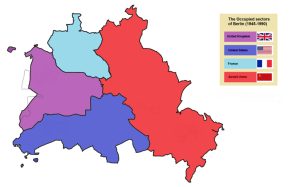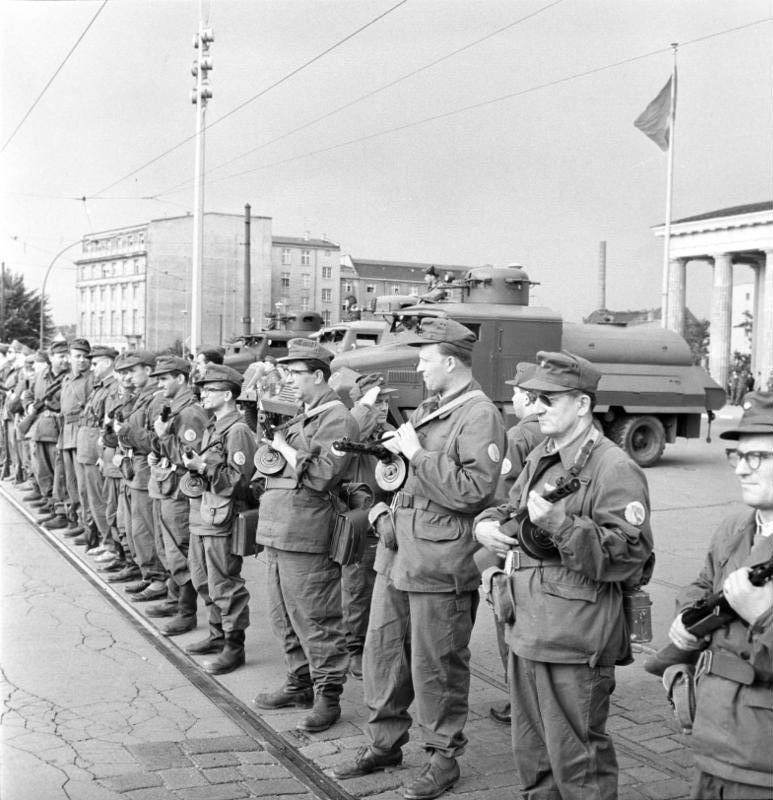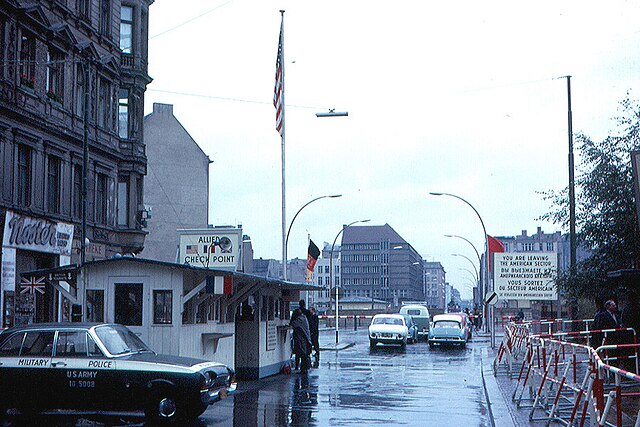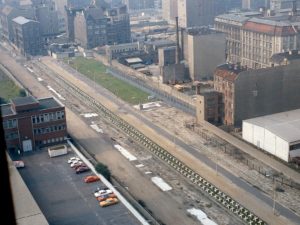
Image: Paasikivi via Wikimedia Commons
In the aftermath of World War II, Berlin was divided into four Allied occupation zones. Although Berlin was deep inside Soviet held territory, this was the situation as the Allied powers decided on the future of Germany. Berlin, of course, had been the capital of Germany prior to and during World War II. Significant differences over that future caused major tensions between the United States, Britain, and France on one side, and the Soviet Union on the other. In 1948 the United States, Britain, and France decided to unite their zones into one entity that became the Federal Republic of Germany This would become West Germany and half of Berlin was in that zone.
The Soviet Union responded by launching a blockage of the city to try and force the Allies to leave. In response, U.S. President Harry Truman along with Britain organized a massive airlift to keep the West German part of Berlin stocked with food and fuel. The Soviets abandoned the blockade in May 1949. Berlin would become the gateway to the West as people would flee East Germany through Berlin. It soon became apparent to the Communists running East Germany they were losing significant portions of their society from intellectuals to skilled laborers. Soviet leader Nikita Khrushchev suggested that East Germany close off access to East and West Berlin.

Photo: Peter Heinz Junge
Source: German Federal Archives via Wikimedia Commons
Starting on the night of 12 August 1961, East German soldiers began placing 30 miles of barbed wire through Berlin and reduced the checkpoints where Westerners could cross into East Germany. Western governments protested but did nothing to stop and on 15 August, the barbed wire was replaced by concrete. East Germany declared that by sealing off their country to the west, the influence of decadent capitalist culture would be stopped. As the wall started going up, many made frantic moves to get across before it was completed. As time went on, the Berlin Wall would grow with walls reaching up to 15 feet high in some places. Streets were now walled up cutting off access to neighborhoods that before could be easily accessed by walking back and forth. The effect was grim as the top of the walls had barbed wire and watchtowers manned with soldiers with machine guns to deter anyone from trying to escape.
The system of walls, and later with electrified wires, would stretch 75 miles around West Berlin, separating it from East Germany. The East Germans also erected barriers on the entire border between East and West Germany. With the erection of this wall, it aptly fit Winston Churchill’s descrption of the Iron Curtain that had fallen in Europe between the democracies of Western Europe and the Communist dictatorships of Eastern Europe. The wall became the most visible symbol of Communist oppression. Many would still try to escape and 5,000 did succeed though many failed either being killed in the attempt or arrested and sent to prison. As the East Germans added even more fortifications, the successful escapes became rare. Checkpoint Charlie became the most visible border between the East and West.

Photo: Roger Wollstadt via Wikimedia Commons

Photo by George Garrigues
Image credit: GeorgeLouis via Wikimedia Commons
By the late 1980’s, the Soviet Union was starting to collapse and many of its client states were starting to feel the pressure of people who resented the oppression they had been forced to endure. It would be on 12 June 1987 that a call would be made that would start a movement that would bring down the Berlin Wall. President Ronald Reagan, in Berlin to celebrate the 750th anniversary of the city, would stand 100 yards away from the concrete barrier and say to the world:
“Mr. Gorbachev, tear down this wall.”
It electrified the crowd and was a major departure from the previous presidents who said nothing. While many in the State Department thought it unwise, Reagan looked at this most visible sign of Communist oppression and said it should come down. Gorbachev dismissed the comment, and many Western leaders thought it a reckless comment. Yet what began was a movement to challenge the Communist leaders in East Germany and elsewhere. And it began to bear fruit when, on 9 November 1989, East Germany announced citizens could cross between East and West Berlin freely. Thousands on both sides went to the wall and began taking the wall down with hammers, chisels, and other tools. The wall would be dismantled in several weeks and 26 years of having a divided city was over. And on 3 October 1990, both East and West Germany were officially reunited ending the separation that had occurred at the end of World War II.
Today only historic signs, photos, and tour guides will point out where the infamous wall once stood. You can see the differences in some areas that have the old Soviet style buildings right next to the modern areas that were once part of West Germany. Rick Steves in his travel show about Berlin shows how much it has changed since those terrible days. The wall put up to keep people from moving from East Germany to the freedom of the west itself is now a memory, with people selling parts of the wall now to collectors.
Sources
Berlin Wall. (n.d.). visitBerlin. https://www.visitberlin.de/en/berlin-wall
Blakemore, E. (2019, November 8). Why the Berlin Wall rose—and how it fell. History. https://www.nationalgeographic.com/history/article/why-berlin-wall-built-fell
The Editors of Encyclopaedia Britannica. (2024e, July 13). Berlin Wall | Definition, Length, & Facts. Encyclopedia Britannica. https://www.britannica.com/topic/Berlin-Wall
Mullen, M. (2020c, August 12). Berlin Wall built. HISTORY. https://www.history.com/this-day-in-history/berlin-wall-built
Pruitt, S., & Pruitt, S. (2024, June 11). How Reagan’s ‘Tear Down This Wall’ Speech Marked a Cold War Turning Point. HISTORY. https://www.history.com/news/ronald-reagan-tear-down-this-wall-speech-berlin-gorbachev
YouTube
